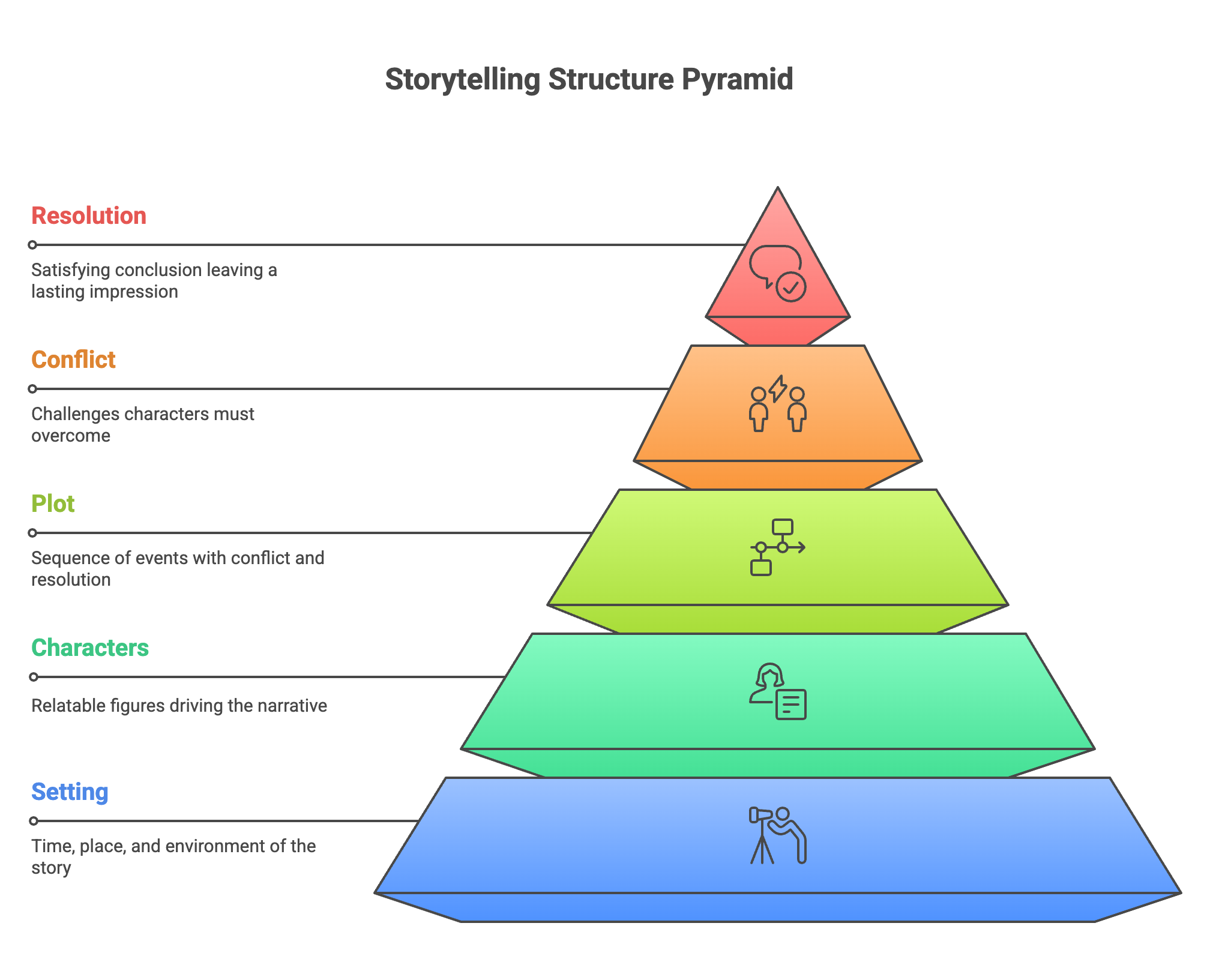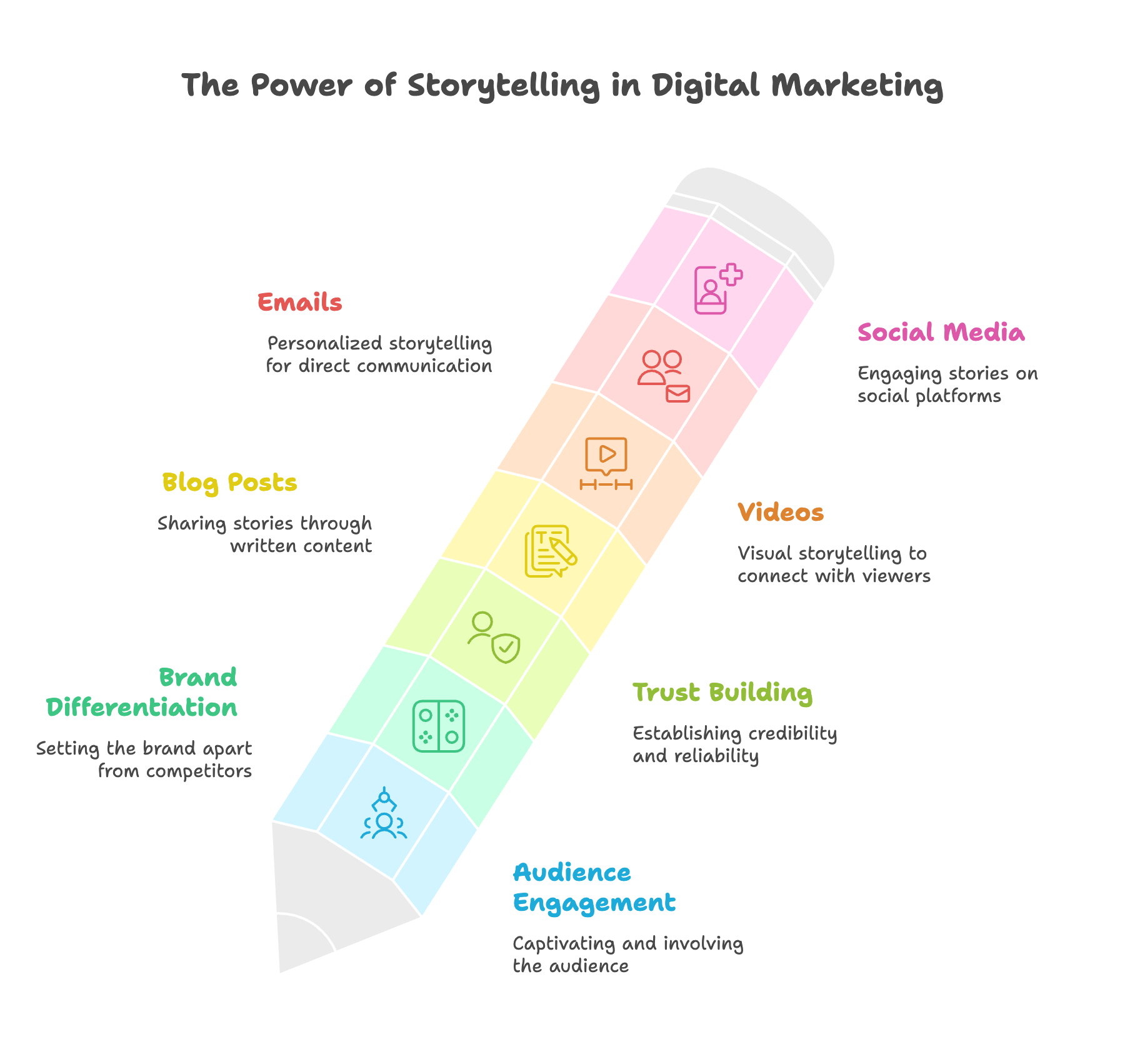Using Storytelling in Digital Marketing and Captivate Your Audience

Storytelling in Digital Marketing
Storytelling is a powerful tool in digital marketing. It helps you connect with your audience, stand out from competitors, and build trust. In today's fast-paced digital world, capturing and retaining your audience's attention is more challenging than ever. Storytelling can make your brand more relatable and memorable, fostering a deeper connection with your audience.
Why Storytelling Matters
Storytelling captures attention and engages your audience. People remember stories better than facts or figures. When you tell a story, you create an emotional connection that makes your brand more memorable. Stories are easier to recall because they engage multiple parts of the brain, making the information more sticky.
Storytelling also helps differentiate your brand. In a crowded market, a compelling story can make you stand out. It gives your brand a unique identity that resonates with your audience. When consumers feel an emotional connection to your brand, they are more likely to choose your products or services over competitors.
Building trust is another key benefit. Stories that reflect your brand's values and mission build credibility. Customers are more likely to trust and stay loyal to brands they feel connected to. Trust is a crucial factor in consumer decision-making, and storytelling can help establish that trust by making your brand more human and relatable.
What does Effective Storytelling look Like
- Setting: Describe the time, place, and environment where your story takes place. This helps create a vivid backdrop for your narrative. The setting can enhance the emotional impact of your story by making it more immersive. For example, a story set in a cozy home can evoke feelings of warmth and comfort.
- Characters: Develop relatable characters that your audience can connect with. These could be your customers, employees, or even your brand itself. Characters drive the narrative and make the story more engaging. For example, featuring real customers in your stories can make your brand more authentic and trustworthy.
- Plot: Create a sequence of events that introduces a conflict, builds tension, and resolves in a satisfying way. This keeps your audience engaged and invested in the outcome. A well-structured plot can make your story more compelling and memorable. Think about the challenges your customers face and how your brand can help overcome them.
- Conflict: Present challenges and obstacles that your characters must overcome. This drives the story forward and creates tension. Conflict is essential for keeping your audience engaged and invested in the story. It also provides an opportunity to showcase how your brand can help resolve these challenges.
- Resolution: Bring your story to a satisfying conclusion. This provides closure and leaves a lasting impression on your audience. A good resolution can reinforce your brand's message and values, making the story more impactful. For example, showing how your product or service improved a customer's life can leave a positive and lasting impression.

Incorporating Storytelling in Digital Marketing
Building a Compelling Brand Story
Define your brand's unique narrative. Identify your brand's origin, values, mission, and vision. Craft a story that communicates your brand's personality and resonates with your audience. Your brand story should be authentic and reflect what makes your brand unique. This can help you stand out in a crowded market and build a stronger connection with your audience.
Develop relatable characters and plotlines. Use customer testimonials or employee stories to add authenticity and emotional connection. Make sure your characters and plotlines align with your brand's values and objectives. For example, featuring real customers in your stories can make your brand more relatable and trustworthy.
Storytelling in Content Marketing
Create engaging blog posts, articles, and social media content. Write about your brand, industry, or customer experiences. Use storytelling to captivate your audience and create an emotional connection. Blog posts and articles that tell a story can be more engaging and memorable than those that simply present information.
Use storytelling in video and visual content. Create videos that tell a story about your brand, product, or customer success. Use visuals to enhance the storytelling experience. Videos are a powerful medium for storytelling because they combine visual and auditory elements to create a more immersive experience. For example, a video showing a customer's journey with your brand can be more impactful than a text-based testimonial.
Leveraging Storytelling in Email Marketing
Create personalized narratives for email sequences. Craft a series of emails that tell a cohesive story. Tailor the narrative to the customer's journey, addressing pain points and providing solutions. Personalized email sequences can make your audience feel more connected to your brand and increase engagement.
Engage customers with captivating email subject lines and stories. Use storytelling techniques to maintain engagement and deliver valuable content. Hook your readers from the beginning, keep the narrative flowing, and include a call to action that aligns with the story's message. For example, an email subject line that hints at a story can increase open rates and engagement.
Storytelling in Influencer Marketing and User-Generated Content
Collaborate with influencers to tell authentic brand stories. Partner with influencers who align with your brand's values. Encourage them to share their experiences with your brand. Influencers can help you reach a wider audience and build credibility by sharing authentic stories about your brand.
Encourage customers to share their own stories. Foster user-generated content through social media campaigns or contests. Share these stories across your digital channels to showcase real-life examples of your brand's impact. User-generated content can be more authentic and relatable, making it a powerful tool for building trust and engagement.

Case Studies
Goettl and Superside: AI-Driven Visual Storytelling
Goettl, an HVAC brand, partnered with Superside to use AI for visual content creation. They created 215 AI-generated visuals depicting family comfort moments. This approach humanized the brand and connected its services to familiar emotions. The result was an 87% reduction in design hours and accelerated campaign iteration.
The use of AI in visual storytelling allowed Goettl to create a wide range of relatable scenarios quickly and efficiently. This not only saved time and resources but also enabled the brand to explore a broader spectrum of emotional touchpoints. By leveraging AI, Goettl was able to create highly specific and authentic-feeling moments that resonated with diverse customer experiences.
Yara International: Stories of Succession in B2B Agriculture
Yara International launched the "Growers for the Future" campaign, focusing on succession in farming communities. The campaign used authentic farmer voices to address emotional realities. This approach built trust and loyalty, differentiating Yara in a technical market.
By tapping into the emotional aspects of farming, such as the fear of failure and the hope for future generations, Yara was able to create a deeper connection with its audience. This emotional resonance helped the brand stand out in a market where products and services are often perceived as purely functional or technical. The campaign demonstrated Yara's understanding and support for farmers, fostering a stronger and more resilient relationship.
Dyson: Cultural Nuance in Video Storytelling
Dyson's Chinese New Year video focused on well-being, subtly integrating animated lanterns formed from Dyson device elements. The video avoided overt sales pitches, instead cultivating an emotional landscape of health and familial warmth. This approach positioned Dyson as a guardian of shared atmospheres, fostering a profound emotional connection.
By connecting its technology to deeply held cultural traditions and aspirations, Dyson was able to create a story that resonated on a deeply personal and cultural level. This approach elevated the brand beyond its functional products, making it relevant to universal human values such as family, health, and tradition. The video's subtle and culturally sensitive storytelling helped Dyson build a stronger emotional connection with its audience.
Take Action How?
Identify Your Unique Story: Conduct interviews with founders, employees, and customers to uncover compelling anecdotes. These conversations often reveal unexpected narrative threads that resonate with audiences. Your brand's unique story can help you stand out and build a stronger connection with your audience.
Develop a Storytelling Style Guide: Include your brand's voice, tone, key messages, visual elements, and character archetypes. This ensures consistency across all your storytelling efforts. A style guide can help you maintain a cohesive brand identity and make your stories more recognizable and memorable.
Tailor Stories to Each Platform: Adapt your narrative to fit the strengths of each digital platform. Use sequential images on Instagram, long-form videos on YouTube, and personalized narratives in email campaigns. Each platform has its unique characteristics, and tailoring your stories to fit these can make them more effective and engaging.
Monitor Engagement: Use analytics tools to track engagement metrics. This helps you refine your storytelling approach based on what resonates most with your audience. By monitoring engagement, you can identify what works and what doesn't, allowing you to continuously improve your storytelling efforts.
Storytelling is a powerful tool in digital marketing. By crafting compelling narratives, you can engage your audience, differentiate your brand, and build trust. Start incorporating storytelling into your digital marketing strategies today to see the impact it can have on your brand. Whether through blog posts, videos, emails, or social media, storytelling can help you create a more memorable and impactful brand experience.

FAQ
Q: What are the key elements of effective storytelling? A: The key elements of effective storytelling include characters, plot, setting, conflict, and resolution. Characters drive the narrative, the plot introduces and resolves conflicts, the setting creates a vivid backdrop, and the resolution provides closure.
Q: How can I write a compelling brand story? A: To craft a compelling brand story, define your brand's unique narrative by identifying its origin, values, mission, and vision. Develop relatable characters and plotlines that align with your brand's values and objectives. Use customer testimonials or employee stories to add authenticity.
Q: How can I use storytelling in content marketing? A: You can use storytelling in content marketing by creating engaging blog posts, articles, and social media content that tell stories related to your brand, industry, or customer experiences. Use videos and visuals to enhance the storytelling experience and make it more immersive.
Q: How can influencers help with brand storytelling? A: Influencers can help by sharing authentic stories about their experiences with your brand. Partner with influencers who align with your brand's values and encourage them to tell stories that resonate with their followers. This can build credibility and reach a wider audience.
Q: What is user-generated content, and how can it enhance storytelling? A: User-generated content involves encouraging your customers to share their own stories and experiences with your brand. This can be done through social media campaigns, contests, or testimonials. Sharing these stories across your digital channels can showcase real-life examples of your brand's impact, making it more authentic and relatable.




